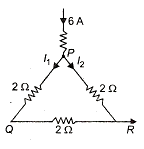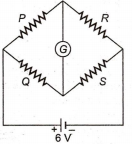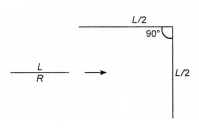 Multiple Choice Questions
Multiple Choice QuestionsDimension of resistivity is
[ M L2 T-2 A-1 ]
[ M L3 T-3 A-2 ]
[ M L3 T-2 A-1 ]
[ M L2 T-2 A-2 ]
A potentiometer has a uniform potential gradient across it. Two cells connected in series (i).to support each other and (ii).to oppose each other, are balanced over 6m and 2m, respectively on the potentiometer wire. The emf's of the cells are in the ratio of
1 : 2
1 : 1
3 : 1
2 : 1
If there is no deflection in the galvanometer connected in a circuit shown in the figure, then the ratio of lengths AC/CB is

4:1
1:4
1:1
2:1
A potentiometer having the potential gradient of 2 mV/cm is used to measure the difference of potential across a resistance of 10Ω. If a length of 50 cm of the potentiometer wire is required to get the null points the current passing through the 10Ω resistor is (in mA)
1
2
5
10
A battery of emf 10 V and internal resistance 3 Ω is connected to a resistor. The current in the circuit is 0.5 A. The terminal voltage of the battery when the circuit is closed is
10 V
zero
1.5 V
8.5 V
A battery consists of a variable number (n) of identical cells, each having an internal resistance r connected in series. The terminals of the battery are short-circuited. A graph of current (I) in the circuit versus the number of cells will be as shown in figure




A current of 6 A enters one comer P of an equilateral triangle PQR having 3 wires of resistances 2Q each and leaves by the corner R. Then the current I1 and I2 are

2 A, 4 A
4 A, 2 A
1 A, 2 A
2 A, 3 A
In the Wheatstone's network given, P = 10Ω, Q = 20Ω, R =15Ω, S = 30Ω, the current passing through the battery (of negligible internal resistance) is

0.36 A
zero
0.18 A
0.72 A
A wire of length L has resistance R. It is bent at mid-point such that the two halves make an angle 90° with each other. The new resistance would be.

R
R
N identical cells, each of emf E, are connected in parallel. The emf of the combination is
NE
E
N2E
E/N
B.
E

The potential difference does not depend upon the path. Eeq = E.
